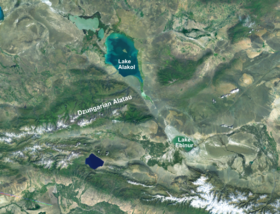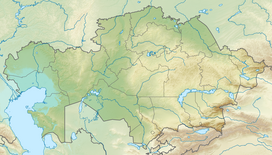阿拉山口
外观
| 阿拉山口 | |
|---|---|
| 准噶尔山口 | |
 阿拉山口地区的卫星照片 | |
| 位置 | |
| 山脉 | 阿拉套山 - 巴尔鲁克山 |
| 坐标 | 45°30′N 82°20′E / 45.500°N 82.333°E |
阿拉山口(蒙古语:ᠠᠯᠠᠭ
ᠠᠭᠤᠯᠠ ᠶᠢᠨ
ᠠᠮᠠᠨ,汉语拼音字母:Alag Ûûlin Am)[注 1],前苏联国家称之为“准噶尔山口”(哈萨克语:Жоңғар қақпасы,罗马化:Joŋĝar k̂ak̂pası)或“七河山口”(哈萨克语:Жетісу қақпасы,罗马化:Jëtisuw k̂ak̂pası[注 2]),是位于阿拉套山和巴尔鲁克山之间的一个山口,也是中华人民共和国和哈萨克斯坦两国的边界要塞及口岸,哈萨克斯坦一侧为杰特苏州萨尔坎德区多斯特克[1]。
阿拉山口长90公里,宽20公里。[2]当地亦以大风见称,常年8级以上的大风天气长达180多天,最大瞬间风力可达到12至13级。国电集团在那里兴建了共15万千瓦的风力发电站。[3]
自从北疆铁路和土西铁路在1990年对接以来,这里就成为了新亚欧大陆桥的一部份。1993年亦开放了公路口岸。2002年,阿拉山口(铁路、公路)出入境人员8.1万人次,出入境交通工具0.99万辆(列)次,进出口货物585万吨。[4]。在中国境内,行政区则隶属新疆博尔塔拉阿拉山口市。
古希腊神话
[编辑]希罗多德在《历史》中记述了旅行者所说的在古希腊世界的东北方有一地,有狮鹫守卫金子,并有山洞中吹出北风。根据希罗多德的故事与阿拉山口的相似点,一些近代学者认为古希腊神话中北风之神波瑞士所在之地与阿拉山口有关。[5][6][7][8]古希腊神话中描述居住在北风之地的另一边的人(Hyperborean)是和平、文明的种族,食用谷物且滨海而居,因此被认为指的是中国人。[6][9]
注释
[编辑]参考文献
[编辑]- ^ 托卡耶夫总统签署组建新行政区划的总统令. 哈萨克国际通讯社. 2022-05-04 [2022-05-04]. (原始内容存档于2022-05-06).
- ^ 阿拉山口——中国向西开放的前沿. 人民网. 2005年9月23日 [2009年12月15日]. (原始内容存档于2016年3月3日).
- ^ 阿拉山口大風“變害為利”新疆又建新風能基地. 新华网. 2009年7月6日 [2011年12月2日]. (原始内容存档于2009年9月8日).
- ^ 阿拉山口陸運(鐵路、公路)口岸. 中国网. [2009年12月15日]. (原始内容存档于2014年3月12日).
- ^ Adrienne Mayor, Peter Dodson, The first fossil hunters: paleontology in Greek and Roman times, Princeton University Press, 2001, p. 27 (See also map, p. 28)
- ^ 6.0 6.1 Wasson, R.G.; Kramrisch, Stella; Ott, Jonathan; et al, Persephone's Quest - Entheogens and the origins of Religion, Yale University Press: 227–230, 1986, ISBN 0-300-05266-9
- ^ Bolton, J.D.P. (1962). Aristeas of Proconnesus
- ^ Lehtinen, Ildikó. Traces of the Central Asian Culture in the North: Finnish-Soviet Joint Scientific Symposium Held in Hanasaari, Espoo, 14-21 January 1985. Coronet Books. 1986. ISBN 978-951-9403-02-1 (英语).
Considering that Pliny, referring to Aristeas, says that the Arimaspeans lived very near 'the Earth's gate' and the 'cave of the North Wind', we must seek them somewhere near the Dzungarian Gate, and not in the Urals or Tibet.
- ^ "If, as some scholars suggest, the Issedones were the Wusun of the western Gobi, the Arimaspi the Huiung-nu of Mongolia, and the Hyperboreans the Chinese, then the sea to which they extended was the Pacific, and Aristeas was 'the first civilized European to pass the Dzungarian Gate and learn of the existence of China'." Klaus Mehnert, Ein Deutscher auf Hawaii, 1936-1941 s.n., 1983, p. 240 (页面存档备份,存于互联网档案馆)


